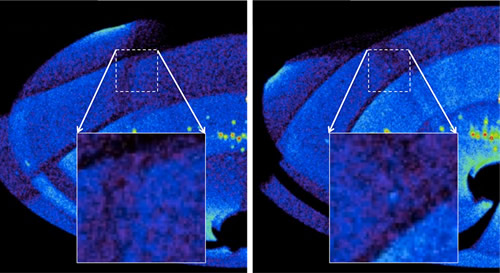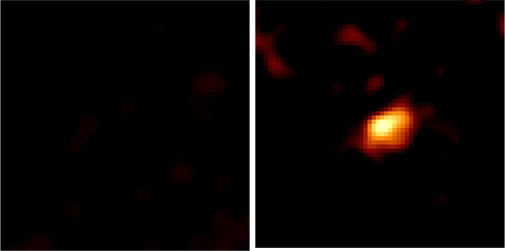Scientific paper in Nature using
the Monitor of All-sky X-ray Image (MAXI) on Kibo and the Swift satellite (USA) observations
- First observation of a massive black hole swallowing a star -
Japan Aerospace Exploration Agency (JAXA)
Institute of Physical and Chemical Research (RIKEN)
The Monitor of All-sky X-ray Image (MAXI) on Kibo, in coordination with the gamma-ray burst satellite Swift (USA), observed the instant that a massive black hole swallowed a star for the first time in the world, located in the center of a galaxy 3.9 billion light years away. This result was published in Nature online, issued on August 25 Japan time. The title of the paper is "Relativistic Jet Activity from the Tidal Disruption of a Star by a Massive Black Hole".
The Swift team, led by Prof. David Burrows of Penn State University, who is also the main author of this paper, detected a strong gamma ray coming from the object located in Draco constellation with a BAT instrument at 21:57 on March 28, 2011 (JST). This object, named Swift J1644+57, continued strong X-ray emissions, so we understood it as different from a gamma-ray burst, as is often observed when a massive star dies and a black hole is born.
Alerted by information from the Swift team, the MAXI team, including JAXA, Riken, and Profs. Nobuyuki Kawai in Tokyo Tech and Hitoshi Negoro in Nihon University, both of whom co-authored the Nature paper, reviewed the MAXI data of this object and found that MAXI had detected X-rays from Swift J1644+57 several hours before the Swift discovery. They also found that there had been no previous X-ray emission before the activity this time.
Detailed analysis of MAXI and Swift observations revealed that the X-ray came from a black hole located in the center of a galaxy sucking down a star. This was the first time that a nucleus with no X-ray emission had ever suddenly started such activity. The strong X-ray and rapid variation indicated that the X-ray came from a jet. Although there have been some other observations to date, namely considered to be tidal disruption and a black hole swallowing a star, they were not as violent as seen this time, and the beginning had not previously been observed.
MAXI was mounted on the Japanese experimental module Kibo on the ISS in July 2009 and has been monitoring the whole sky since August 2009. Moreover, MAXI can not only detect transient objects, but is also capable of investigating the state of objects prior to the phenomenon, which led to the current discovery. The X-ray camera with MAXI can detect low-energy X-rays, enabling wide-ranging coverage when combined with Swift BAT. Continual monitoring of MAXI will lead to further new discoveries in future.
- Reference
- "Relativistic Jet Activity from the Tidal Disruption of a Star by a Massive Black Hole"
(10.1038/nature10374) by David Burrows (Penn State University, USA)
- Co-authors in the MAXI team:
- Nobuyuki Kawai, Ryuichi Usui (Tokyo Tech)
Mutsumi Sugizaki (Riken)
Yoshihiro Ueda, Kazuo Hiroi (Kyoto University)
Hitoshi Negoro (Nihon University)
http://maxi.riken.jp/
Home page of Swift
http://swift.gsfc.nasa.gov/
X-ray Image of Swift J1644+57 by MAXI

Figure 1 Swift J1644+57 on daily updating MAXI all-sky X-ray Image (partial and zoomed)
Left: MAXI one week before the burst, March 21, 2011. No X-rays were emitted.
Right: March 29, 2011. Swift J1644+57 was detected clearly. These images contain background noise caused by charged particles in orbit, which form scanning patterns (lines).

Figure 2 Accumulated X-ray image of the Swift J1644+57 region by MAXI (6x6 degrees2)
Left: From September 1, 2009 to March 31, 2010. No activity from Swift J1644+57.
Right: From March 28, 2011 to April 3, 2011. The bright image (center) is the Swift J1644+57. These images were calibrated to show equivalent brightness regarding X-ray energy by removing no X-ray noise.
Significant result by MAXI
Since MAXI started all-sky X-ray observation on Kibo's Exposed Facility in August 2009, it has discovered many unexpected celestial X-ray events, and provided global alerts of the same. In addition to the X-ray flares of stars or X-ray novae caused by black holes and neutrons in our Galaxy, MAXI has detected X-rays from Active Galactic Nuclei (AGNs) or gamma-ray bursts several billion light years away. MAXI has been notifying them as alerts to astronomers via the Internet. MAXI has also detected some unknown objects such as MAXI J1659-152 (black hole binary) and MAXI J1409-619 (X-ray pulsar).
|
|